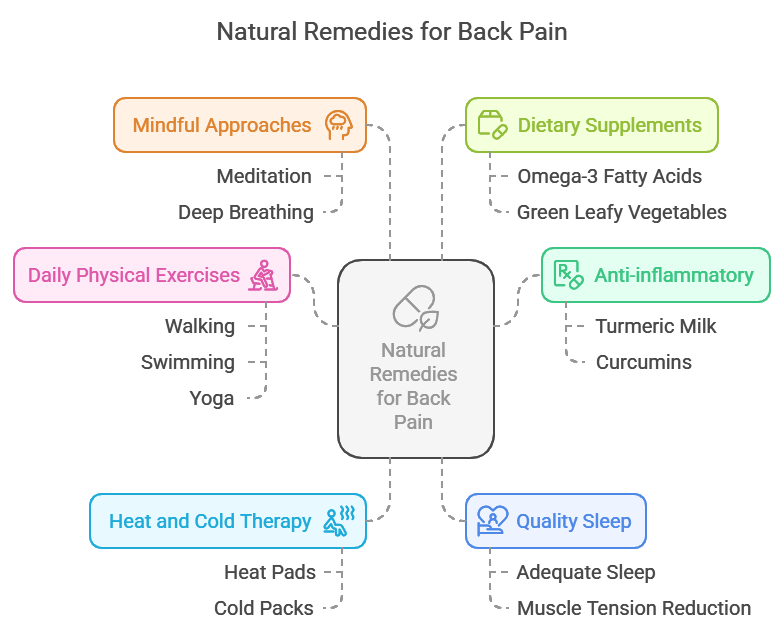Back Pain – Causes, Symptoms, and Effective Relief
Lifestyle Changes to Reduce Back Pain Naturally
Lifestyle modification can reduce pain intensity and improve functional mobility. Combining traditional therapy with physical exercises has shown benefits in pain reduction. Similarly, exercises for lumbar support and resistance training can enhance spinal support and reduce discomfort.
Incorporating daily exercises, having healthy weight, sufficient sleep, nutritional diet, and avoiding stress are all lifestyle factors that can cooperate to the reduction of the back pain. By easily adapting these changes, can improve overall health and lower the risk of severity and back pain frequency.

What are the best natural remedies for Back Pain?
Natural remedies for back pain involve a combination of life adjustments, dietary modifications, and physical exercises. These remedies are complementary to medical treatments, and in some conditions, provide significant relaxation.
Anti-inflammatory –
Supplements with anti-inflammatory properties can help to reduce pain. Turmeric milk, made by merging turmeric powder with warm milk, which contains curcumins, has antioxidant and anti-inflammatory effects on the body, if consumed regularly.
Daily physical exercises –
Practicing gentle exercises like – walking, swimming, and yoga or meditation can strengthen core muscles which supports spinal health and improves flexibility. These exercises can increase blood flow to the spine and maintain overall well-being.
Heat and Cold therapy –
Application of heat pad or cold pack to the affected area can alleviate inflammation and pain. Basically, cold packs reduce inflammation and numbness, while heat pads are used to reduce muscle tension and improve circulation of blood.
Quality sleep –
Adequate and sufficient sleep is essential for alleviating pain. Insufficient sleep can increase back pain through muscle tension and reduce healing ability of the body.
Mindful Approaches –
Meditation, yoga, and deep breathing can manage stress, and anxiety, which can in return reduce muscle tension and pain.
Dietary supplements –
Anti-inflammatory diets, such as omega-3 fatty acids, fruits, and green leafy vegetables can support spinal health.
Incorporating these natural remedies into a regular routine can manage back pain but it is also important to seek doctor suggestions before starting any new treatment plan.
Can diet and nutrition help with Back Pain?
A balanced diet is essential in treating back pain as it helps reduce inflammation, spinal health, and increase muscular function.
These modification changes as –
- Diet rich in protein can lower the risk of severe back pain.
- Anti-inflammatory foods, like berries, omega-3 fatty acids, leafy greens, turmeric, and ginger can reduce inflammation in the body.
- Calcium, magnesium, and vitamin D provide bone strengthening and nerve function.
- Proper hydration is also important for spinal health.
How does yoga help with Back Pain?
Yoga is a comprehensive way of managing back pain, which can lead to improvements in pain management, function of spine, and overall health. As a holistic approach, yoga offers benefits that extend beyond physical relief from pain but also manage mental and emotional health.
Benefits of practicing yoga for back pain:
- Reduction in pain and discomfort
- Improve spinal mobility and health
- Enhance quality of sleep
- Help to avoid use of medications
It is important to understand that improper technique or overexertion can increase pain. Therefore, it is recommended to practice yoga under guidance of trained experts, especially those who are new to this practice or those with existing spinal problems.
Does hydration affect Back Pain relief?
Yes, drinking enough water plays an important role in alleviating back pain by supporting spinal health, mobility and reducing muscle tension.
Lets see how water intake impacts Back Pain :
- Maintain spinal health as intervertebral discs in the spine are mainly composed of water. Proper hydration helps these spinal discs to retain their height, flexibility, and cushioning between vertebrae. If discs are dehydrated it can lead to shock absorption and increase the risk of injury.
- Adequate hydration helps muscles to receive necessary nutrients and maintain elasticity.
- Water is crucial for managing synovial fluid that lubricates joints, well hydrated joints move freely with reducing friction. Hydrating the body is a simple yet most effective approach to manage spinal health and reduce back pain.
What daily habits can prevent Back Pain?
Daily modifications that can prevent back pain:
- Maintain proper posture
- Stretching exercises
- Core muscle activation
- Maintaining proper posture
One of the primary causes of back pain is incorrect posture, which can lead to spinal misalignment. Habits of slouching, forward bended head, and sitting not correctly can lead to excessive strain on the spine, which can result in pain and discomfort. To maintain correct posture, consider using an ergonomic workstation or standing desks to keep shoulders relaxed and straight with feet flat on the floor.
- Stretching exercises
Exhausting work routine can weaken the core muscles and back, stretching exercises can help to strengthen muscles and increase flexibility.
- Core muscle activation
Core muscles are important for supporting the spine and alleviating strains on the back. Yoga can provide flexibility and stability to the spine.
Summing up..
In conclusion, adapting lifestyle modifications that aim to focus on holistic approaches can alleviate back pain and support overall health.
Simple adaptation of maintaining correct posture, proper hydration, and daily stretching exercises like yoga can manage and prevent back pain.
Moreover, nutritional diets also support spinal health.
But it is important to note that these natural remedies can be effective but still it is necessary to consult a doctor before incorporating any new adjustments.
Reference
- Hewlings S, Kalman D. Curcumin: A Review of Its Effects on Human Health. Foods. 2017 Oct 22;6(10):92. Available from: https://www.ncbi.nlm.nih.gov/pmc/articles/PMC5664031/
- Huang R, Ning J, Chuter VH, Taylor JB, Christophe D, Meng Z, et al. Exercise alone and exercise combined with education both prevent episodes of low back pain and related absenteeism: systematic review and network meta-analysis of randomised controlled trials (RCTs) aimed at preventing back pain. British Journal of Sports Medicine. 2019 Oct 31;54:bjsports-2018-100035.
- Marcos A, Manonelles P, Palacios N, Warnberg J, Casajús JA, Pérez M, et al. Actividad física, hidratación y salud. Nutrición Hospitalaria. 2014 Jun 1;29(6):1224–39. Available from: https://scielo.isciii.es/scielo.php?script=sci_arttext&pid=S0212-16112014000600003&lang=e
- Srinivas G. FITPAA. 2024. Available from: https://www.fitpaa.com/blog/what-is-the-role-of-hydration-in-back-pain-prevention/
- Chang DG, Holt JA, Sklar M, Groessl EJ. Yoga as a treatment for back pain: A systematic review of the literature. Journal of orthopedics & rheumatology. 2016;3(1):1. Available from: https://pmc.ncbi.nlm.nih.gov/articles/PMC4878447/
- Coutinho AE, Chapman KE. The anti-inflammatory and immunosuppressive effects of glucocorticoids, recent developments and mechanistic insights. Molecular and Cellular Endocrinology. 2011 Mar 15;335(1):2–13.
- Daily JW, Yang M, Park S. Efficacy of turmeric extracts and curcumin for alleviating the symptoms of joint arthritis: A systematic review and meta-analysis of randomized clinical trials. Journal of Medicinal Food. 2016 Aug 1;19(8):717–29. Available from: https://www.ncbi.nlm.nih.gov/pmc/articles/PMC5003001/









